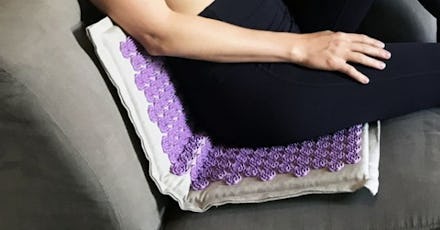Can acupressure mats actually help your pandemic-ravaged body?

All this time at home isn’t doing our bodies any favors. Sitting at our desks for hours on end, likely with fewer outlets for physical activity than usual, has turned us into sore, stiff shells of our pre-pandemic selves. It’s no wonder I've been seeing acupressure mats on my social media feeds. These mats, like the mylotusmat, Bed of Nails, and Dosha Mat, are embedded with plastic spikes that dig into your back and supposedly relieve pain through acupressure.
As someone who’s noticed a recurring, likely slouch-induced throbbing in her lower back, I’m intrigued. But as a health reporter, I’m also perennially wary of buzzy wellness products. Do acupressure mats actually work?
To untangle the evidence from the hype, I consulted with Michael Fredericson, a sports medicine physician at Stanford Health Care certified in medical acupuncture. He tells me these mats may provide pain relief for some people — but probably not in the same way as traditional acupressure does.
First though, some background on acupressure: Acupressure is similar to acupuncture, which originated in China thousands of years ago. Both involve simulating highly specific points in the body, which lie along pathways called meridians. “The idea is that the energy in your body flows through these meridians, and if there’s any blockage or imbalance in the flow of that energy, that can lead to pain or disease,” Fredericson explains. Acupressure unblocks these meridians using deep pressure, rather than the needles acupuncture uses.
There’s definitely evidence to support the use of traditional acupuncture and acupressure for chronic pain, especially muscle pain, Fredericson says. “That, I think, is well-proven. I think the question is whether these generic mats are able to precisely stimulate those points to give you the same type of effect.” At this point, “we just don’t know.” It makes sense: Where these spikes hit will vary from person to person, and maybe even from one use to the next depending on how you position yourself on them.
In other words, acupressure is more sophisticated than lying on a mat with strategically arranged spikes. With that many spikes, you may hit a few acupressure points due to probability, but not all. “It takes a lot of training, even for someone learning to be an acupuncturist or acupressurist, to really find those points,” Fredericson says. “That’s what makes it an art.”
But based on the glowing reviews of these products, they seem to be doing something, even if it may not be acupressure. One Dosha Mat user reports that it “works like a charm for [their] daily back pain,” while a Bed of Nails user gushes about their “stress levels and muscle ache going down and nearly disappearing.”
What these mats likely trigger is a general sense of relaxation that isn’t specific to any precise acupressure points, Fredericson says, “as kind of a deep massage of the muscle.” Not unlike foam rollers, the spikes apply pressure to a tender muscle, which releases in response, regardless of whether they’re stimulating an exact acupressure point. I also wonder if the placebo effect might be at work — that is, whether the expectation that these mats will soothe their achy muscles might shape consumers’ experience of it.
While Dosha Mat and Bed of Nails’ mats hover a little under $100, you can find acupressure mats from other brands in the $20 to $30 range on Amazon. Is an acupressure mat worth it, though?
“There’s no harm in trying it. It might work for some people,” Fredericson says, adding that it’s convenient — you can use it whenever you want, from the safety of your own home. “But I would not say it’s just as effective as traditional acupuncture or acupressure.” Although acupressure mats appear to be generally safe, Fredericson does recommend being careful if you’ve had a recent injury, which the spikes could worsen by applying increased pressure to areas that just aren’t ready to handle it yet.
Basically, an acupressure mat may help you find relief after a day of slouching at your desk. But the use of the term “acupressure” in the name might be more marketing than anything else.